Here is everything you need to know about baby-led weaning with chicken, from a pediatric registered dietitian and mom. Whether you’re doing baby-led weaning, spoon-feeding, or a combination, this post will walk you through, step-by-step how to safely introduce chicken to your baby.
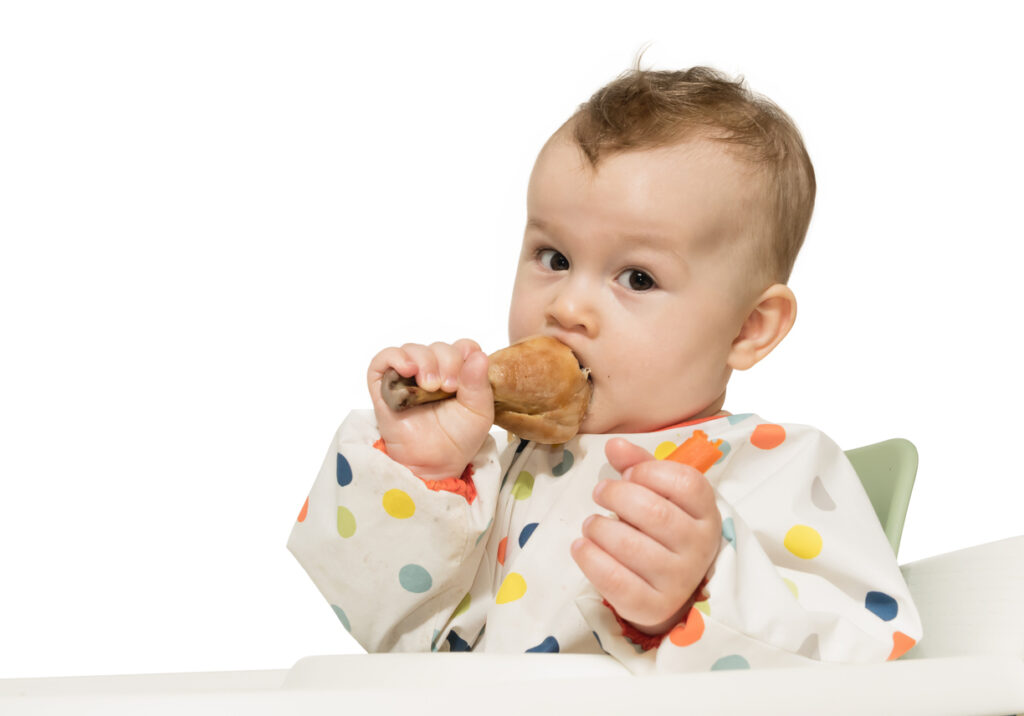
Chicken happens to be the most popular meat in Canada, and the amount consumed per capita continues to grow every year. It’s a lighter meat in color and flavor when compared pork or beef, making it an easy choice to incorporate into nearly any dish. Its versatility no doubt plays a factor in its popularity too. If you’ve got a wee one, it’s important to learn how to safely introduce chicken to your baby. Many parents are concerned about certain foods (like chicken) being a choking hazard. Don’t worry… I’ll explain everything you need to know to safely incorporate it into your baby’s diet.
Need personalized nutrition support?
Book an appointment with one of our pediatric dietitians today!
When to introduce chicken to baby
You can introduce chicken to your baby as soon as they are ready to start eating solids. Typically, babies start to show signs of readiness for solids foods around 6 months of age. Some babies will be ready (and show signs) earlier, while others may take closer to 7 months. Every baby develops at their own pace when it comes to eating (and everything else!). Let your baby lead always, and pay attention to their cues–you will find that your little one is incredibly intuitive when it comes to eating. If you have any feeding concerns or would like some one-on-one advice when it comes to introducing solids, please do not hesitate to book an appointment with a pediatric dietitian who specializes in this area.
What is baby-led weaning and how does it work with chicken?
Baby-Led Weaning is a starting solids strategy that involves offering your baby larger pieces of soft-cooked whole foods that they can feed themselves, as opposed to the parent spoon-feeding purees. At around 6 months old, your baby can independently eat soft, safely-prepared finger foods, strengthening their oral motor muscles and manual dexterity required to bring food up to their mouth. There’s no one “right way” to introduce solids, and quite frankly, I recommend a combination of both finger foods and spoon-fed purees and minced foods. As long as you’re feeding “responsively”, meaning that you’re following baby’s cues, you’re good to go. Both Baby-Led Weaning and spoon-feeding are great (you can read more about BLW vs. purees here).
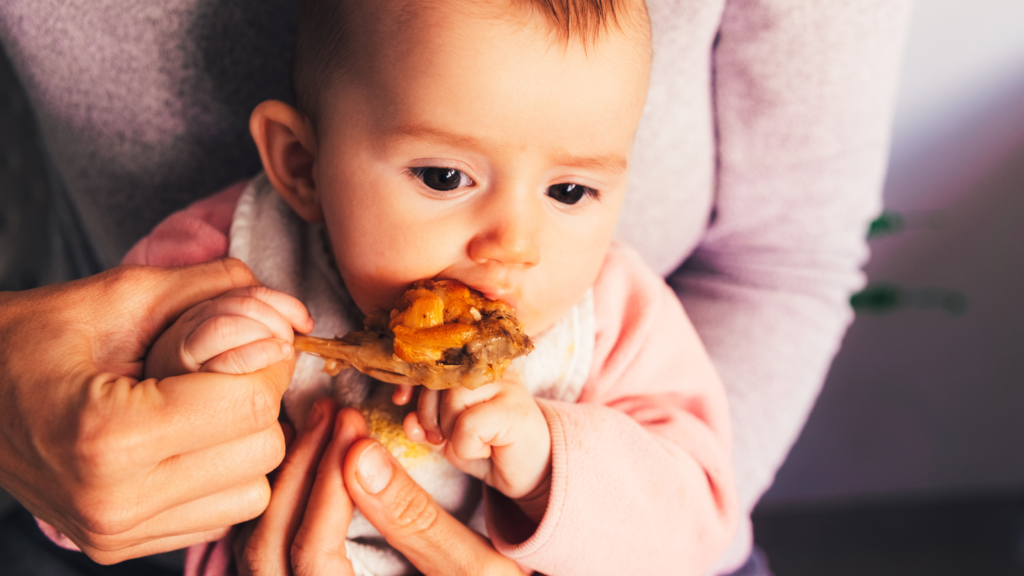
If you’re choosing to offer chicken as a soft, safe finger food, they will use their “palmer grasp” at first, which means grabbing the food in a raking motion with the palm of their hand. Once they’re a little bit older (around 9-10 months), they will develop the “pincer grasp”, which is when you can start offering smaller pieces of food that they can pick up with their thumb and index finger. At around this time your little one will also be able to practice bringing spoons up to their mouth too! This is especially relevant when offering ground chicken in a sauce, as it can be preloaded onto a spoon for your baby to bring to their mouth.
Why is chicken an ideal baby-led weaning food?
Chicken is an ideal baby-led weaning food, not only because of its versatility, but also the fact that it’s a nutritional powerhouse. It is a good source of iron which is a key nutrient of focus for babies when they start eating solids. Babies are born with some iron stores from mom, but will use up these stores over the course of their first six months. It’s important to focus on food sources of iron right from 6 months of age, so serving chicken is a great way to do that!
Chicken can be served in a variety of ways, from ground in a sauce or in meatball form, cooked and shredded, or served directly on the bone as a drumstick! Having so many options is ideal for exposing your baby to a range of different textures and flavors using chicken.
Although any part of the chicken is fine (breast, thigh, drumstick etc.), I prefer to serve babies the dark meat coming from the thigh or drumstick for a couple of reasons. The darker meat is higher in iron than the breast, higher in fat (which babies need) and soft and more tender (which is deal for serving as a finger food).
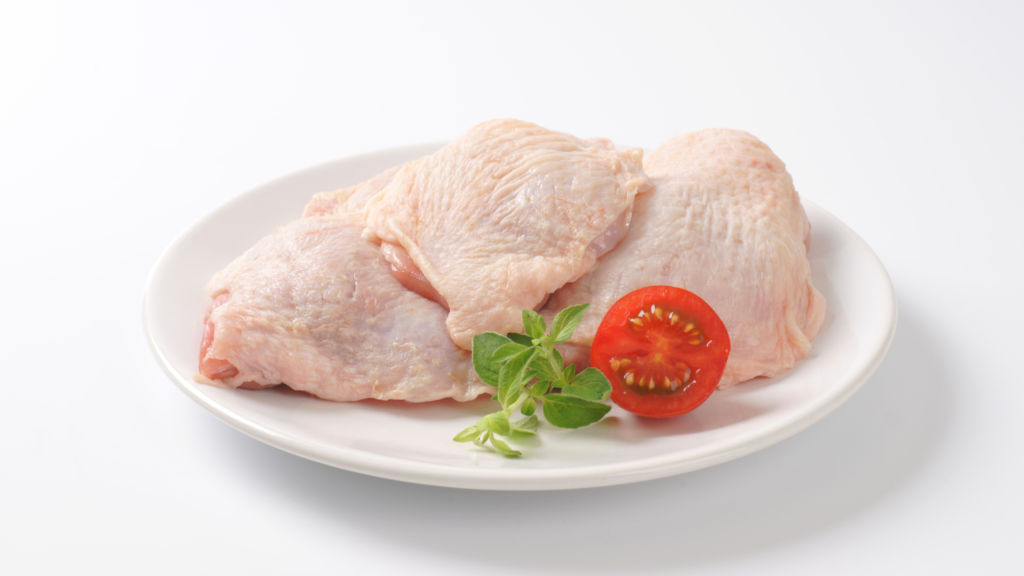
Benefits of chicken:
2 oz. of cooked chicken thigh provides (2):
- 12g of Protein: the building blocks that are essential for your baby’s overall growth and development
- 6%daily requirements of Iron: important for your baby’s growth and development, an essential nutrient in the delivery of oxygen to organs and tissues as well as hormone production.
- 24% daily requirements of Vitamin B12: essential for the maintenance and development of healthy blood and nerve cells in your little one, and a key nutrient in making genetic material.
- 38% daily requirements of Selenium: a key mineral in supporting a healthy immune system, protecting your baby from infection, and important for thyroid function and DNA production.
- 18% daily requirements of Zinc: essential for helping your baby fight off bacteria and viruses, as well as wound healing and supporting healthy growth and development.
Food safety with chicken, for baby-led weaning
Undercooked or raw chicken contains harmful bacteria that can cause serious illness if consumed. This is especially true for babies who have underdeveloped immune and digestive systems. For this reason, it is essential that you cook all cuts of chicken (or ground chicken) to an internal temperature of 165°F. If you’re cooking a whole roasted chicken (stuffed or unstuffed) it must reach an internal temperature of 180°F. You can be confident that if your cooked chicken reaches these internal temperatures the meat will be free from all harmful bacteria. How do you know if it reaches the proper internal temperature? You need a meat thermometer! Check out this popular digital meat thermometer if you don’t already have one.
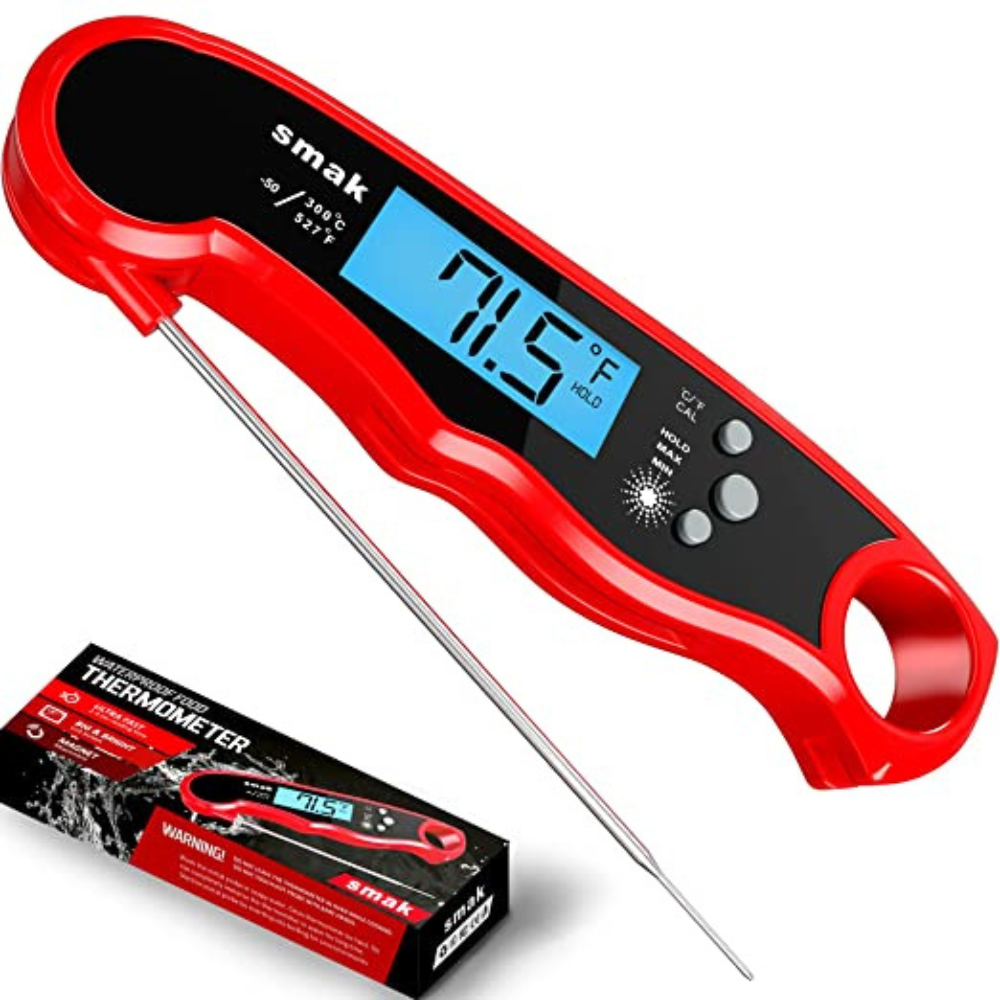
After handling and preparing raw chicken, be extra careful to clean all contaminated surfaces thoroughly. After cleaning your hands with soap and hot water, don’t forget to clean the sink facet/ taps that you touched. Be sure to use a separate cutting board for the raw chicken if you are preparing other foods as well. Never ever rinse raw chicken, as the running water can easily splash around the sink vicinity, increasing risk of bacterial contamination.
How to store cooked chicken for baby:
Chicken cooked at home should be put in the refrigerator before the two-hour mark to prevent bacterial growth. You can store cooked chicken in the fridge for up to 24h before reheating and serving to your baby. If you plan to batch cook chicken or homemade purees containing chicken, you can freeze extra portions for later use in the freezer for 1-2 months. Food storage times are less for infants when compared to adults; their immune and digestive systems are not fully developed yet, increasing risk of food-borne illness.
How to serve chicken to your baby:
In my family, our favorite way to eat chicken is after it’s been cooked to a tender moist texture, and then shredded! I also find shredded chicken to one of the most versatile and least time-consuming methods of preparation! I dump raw chicken thighs or breast into my instant pot or slow-cooker with some low-sodium chicken broth, and pressure cook them on high for about 30 minutes or until they are tender and fall apart easily. I drain the broth then shred the chicken with two forks. I find shredded chicken works well to batch cook and freeze a portion for later use. We enjoy adding shredded chicken to pastas, soups, tacos, sandwiches and more! For a new eater, simply serve tender, shredded chicken on its own to start, then add to other dishes for further exposure along their chicken-eating journey.
Ways you can safely serve chicken through baby-led weaning:
Shredded chicken:
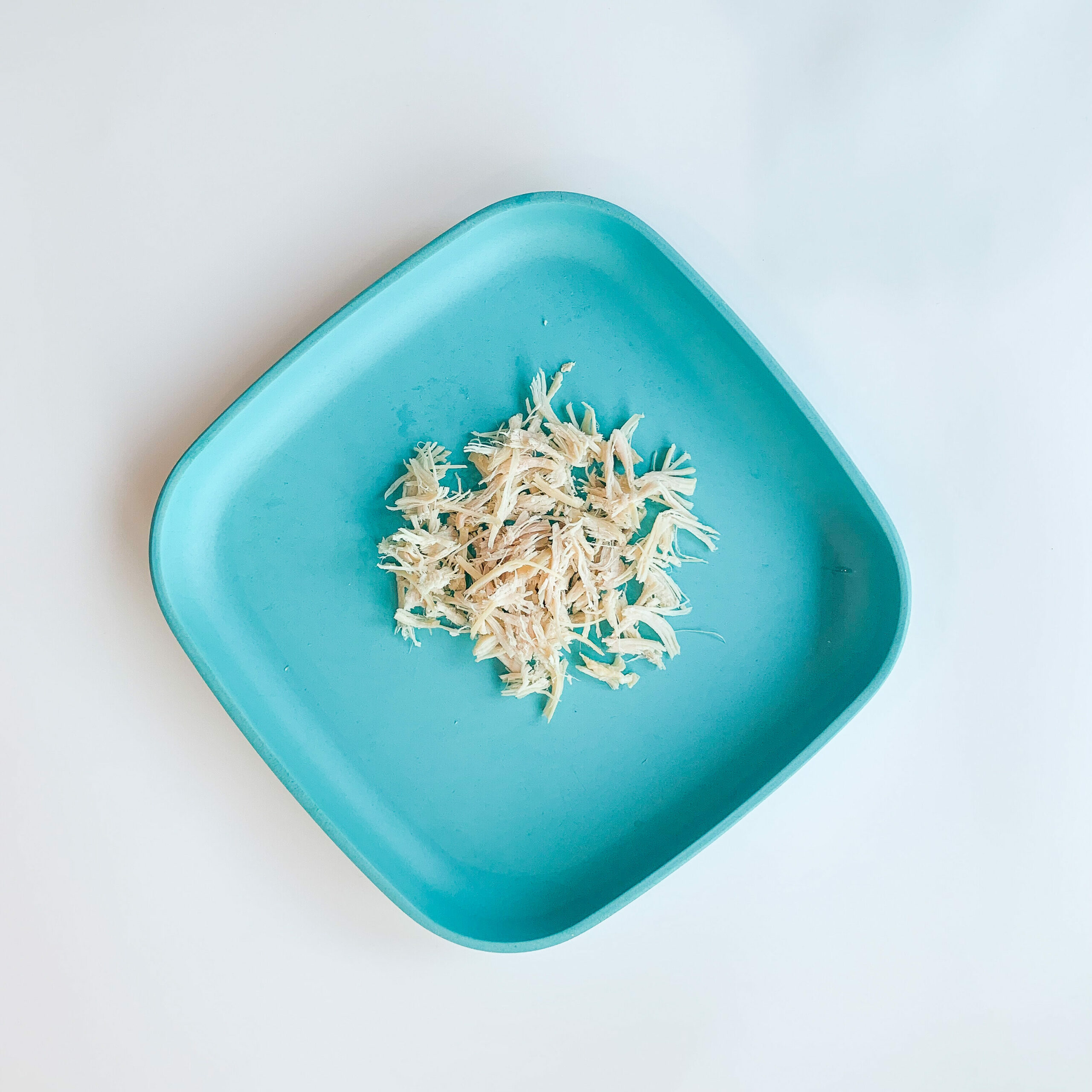
Use a moist cooking method (pressure cook/slow cook) boneless, skinless chicken breast or thighs, then shred when the meat is fully cooked and falls apart easily. Serve small shredded pieces of chicken to baby, chop longer shreds up to shorter pieces so that they can be more easily swallowed. If you find the meat is too dry (and therefore hard to swallow), drizzle on a small amount of olive or low sodium broth/tomato sauce to add back some moisture.
Chicken strips:
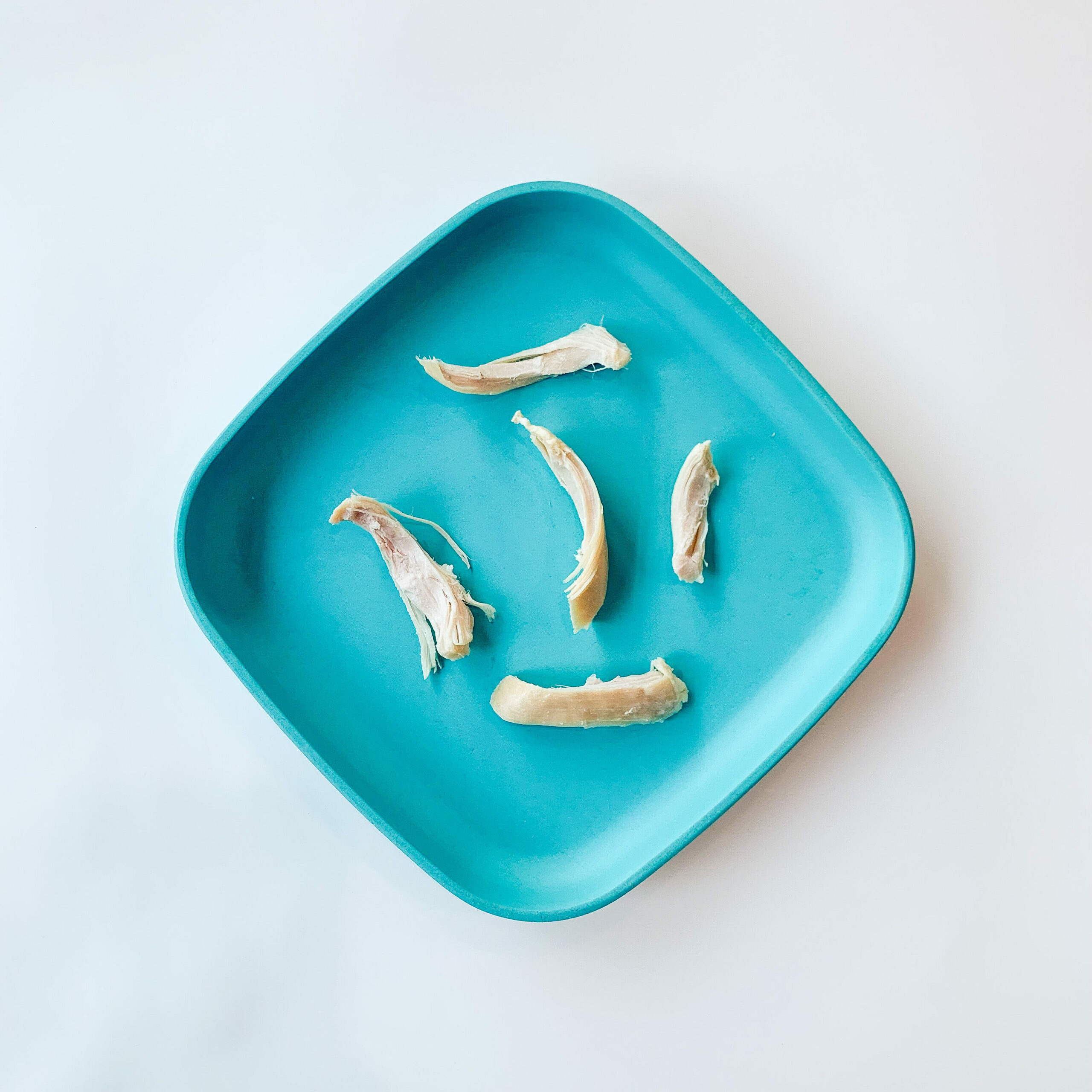
Shred moist cooked chicken into larger “fingerlike” strips that are easier for baby to grasp in their fist between the ages 6-9 months. When they develop their “pincer grasp” at around 9-10 months you can start serving smaller pieces of chopped (soft/moist) chicken to baby to help them practice this fine motor skill using their thumb and index finger.
Chicken drumstick:
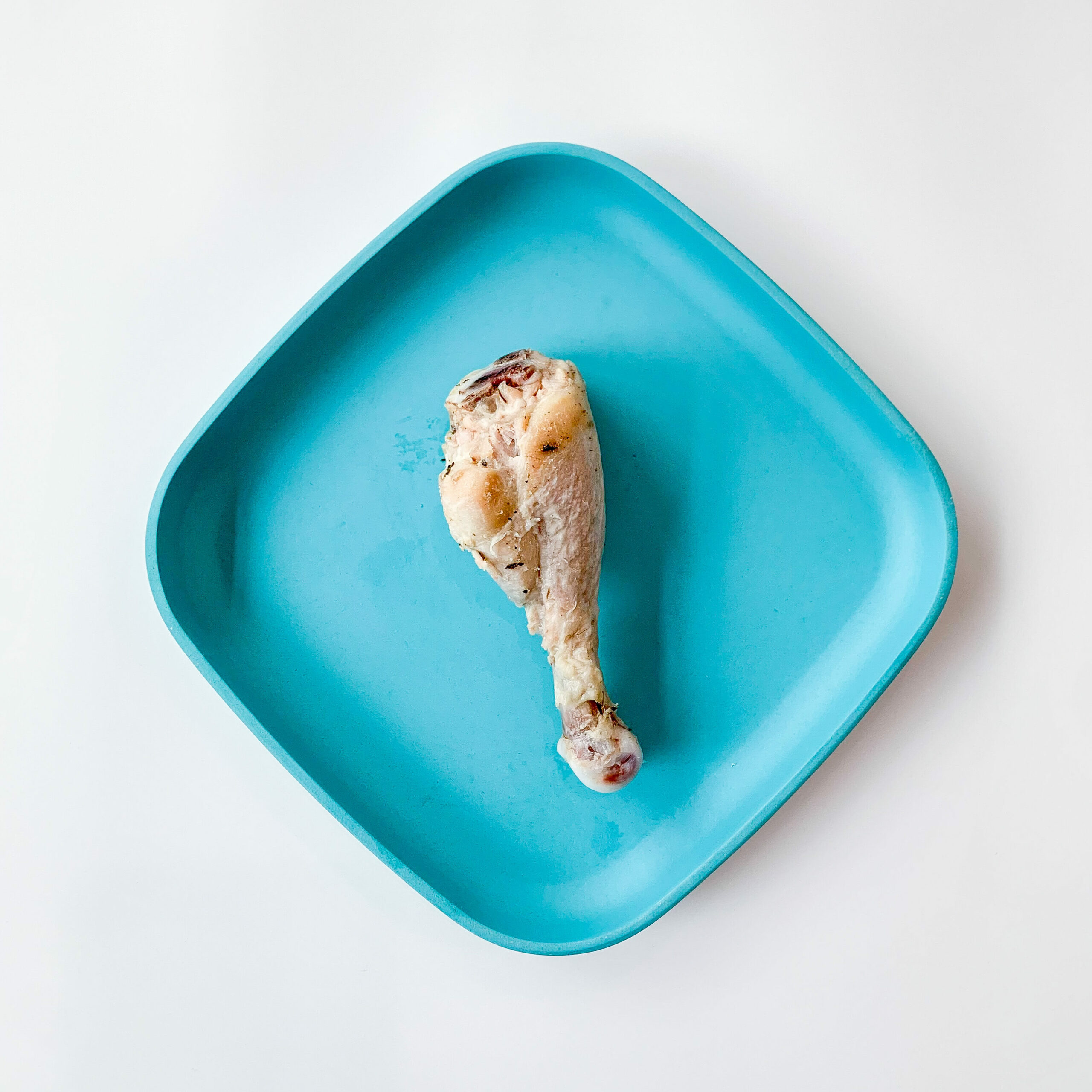
Ensure you thoroughly cook chicken drumsticks to an internal temperature of 180°F. Since they have the bone in, it can take them longer to cook than other boneless cuts of chicken. Let the drumstick cool, and remove the skin, and other rubbery cartilage bits from the bone that could post a choking risk to your little one. Drumsticks are a great size and shape for your baby to practice their “palmer grasp” between the ages of 6-9 months old!
Ground chicken in sauce:
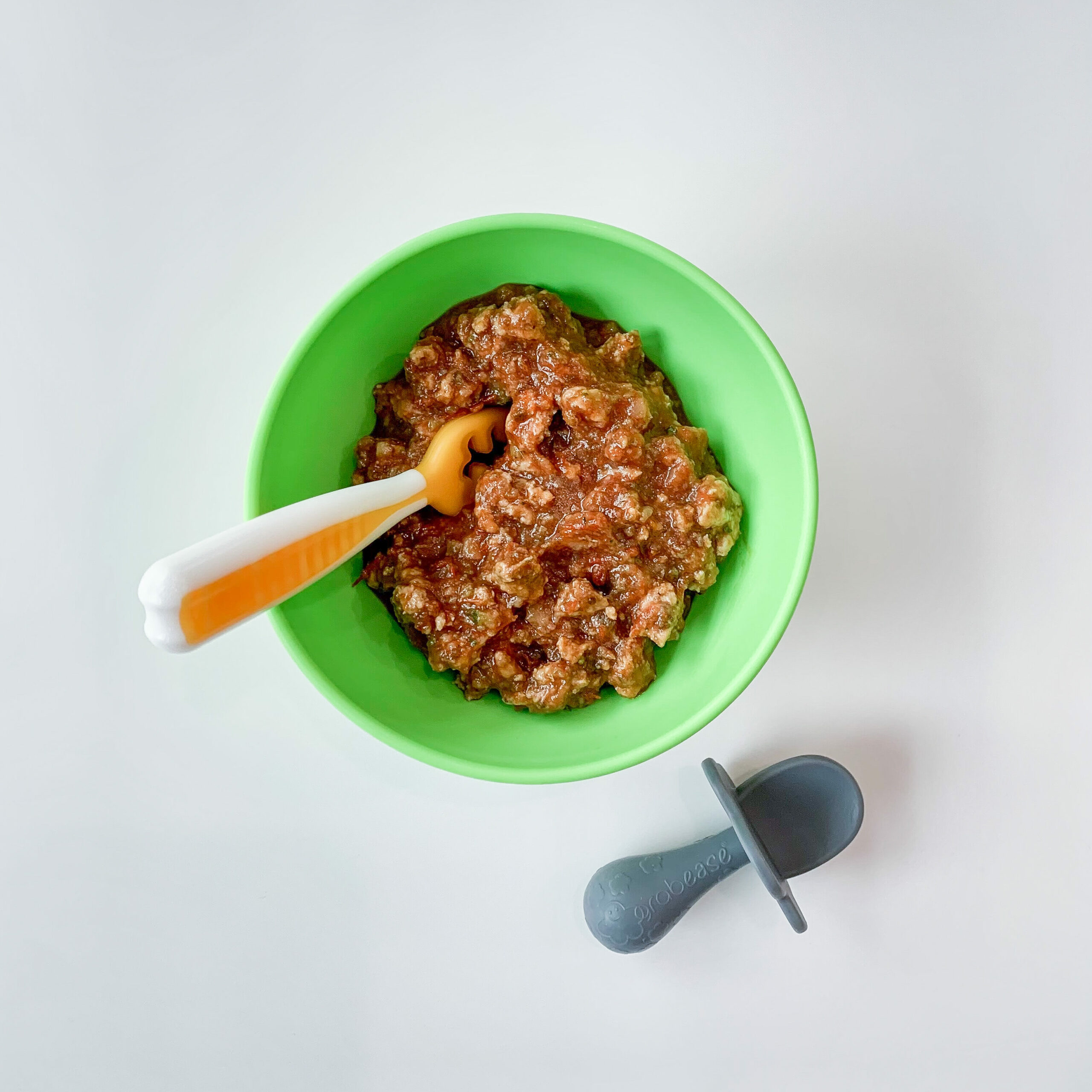
cooked ground chicken on its own can be rather dry, which is why I recommend adding a sauce or mash/puree to ground chicken before serving to your baby. This will help the minced chicken pieces slide more easily down your baby’s throat, reducing risk of it getting stuck on the way down. Make sure that larger/ chunkier pieces of cooked ground chicken have been broken down in the sauce before serving to your little one to help reduce choking risk. Ground chicken in no-salt-added tomato sauce, mixed with pureed carrot (and/or other vegetables) can be added over soft cooked pasta to balance out the meal for your little one!
Ground chicken meat balls/patties:
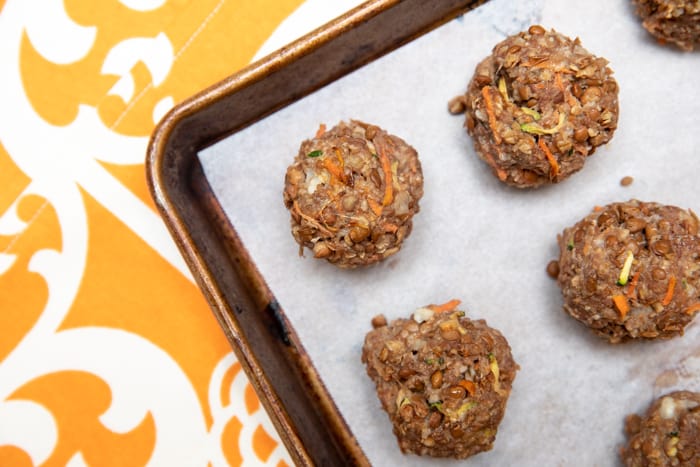
I recommend shaping meat balls into “fingers” instead of the typical round ball shape, as meat fingers are easier for your little one to pick up, especially between the ages of 6-9 months. As your little one’s fine motor skills develop, start cutting up meat-balls or patties into smaller pieces so your little one can practice their pincer grasp (which usually happens at around 9-10 months of age). Here’s a great recipe that you can use either chicken or turkey in: Baby chicken meatball recipe.
Chicken puree:
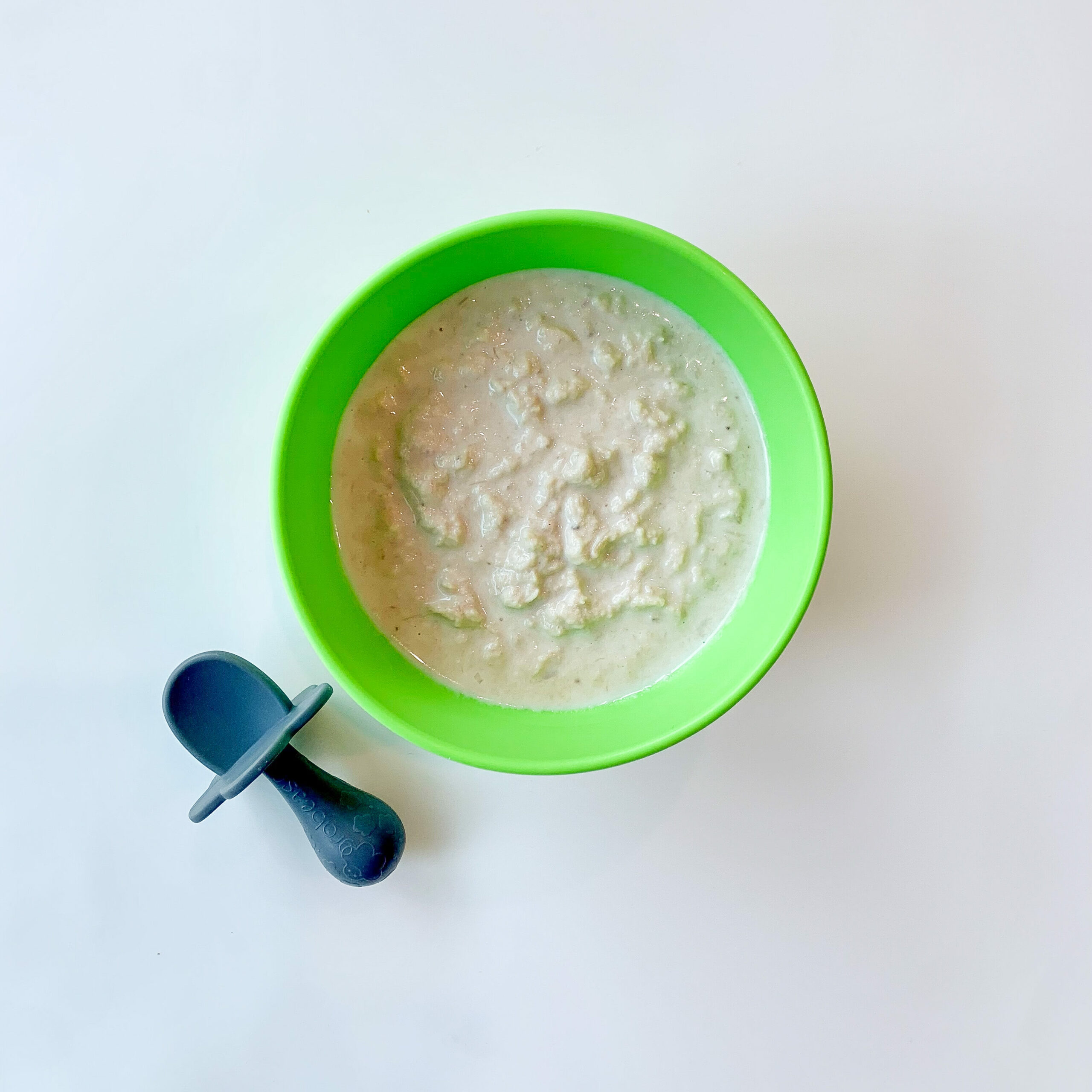
Pureed, cooked chicken (mixed with formula or breastmilk to bump up the nutrients) is a great option too. You can also use no-salt-added chicken broth for the liquid. Use a food processor or high-powered blender and add more or less liquid to thicken or thin out the pureed chicken. To make the chicken puree into a balanced meal option, blend in a fat (like avocado, olive oil, or hemp hearts), a starch (like sweet potato/winter squash, cooked oatmeal or pasta) and vegetable and/or fruit (like cooked broccoli/carrots or steamed pears/apples). Serve chicken puree on a preloaded spoon that your baby can bring it up to their own mouth if they are 9 months or older. If your little one is less than 9 months old, they will struggle to efficiently use a spoon, in which case you can spoon-feed them yourself, while following their cues!
Baby-led weaning meals using chicken:
Breakfast ideas:
- Chicken banana puree on toast: Puree cooked chicken with banana, a drizzle of olive oil and some formula or breast milk to make a thicker spreadable puree. Spread over whole grain toast and cut into strips before serving to your baby for breakfast!
- Apple shredded chicken and waffles: mix moist shredded chicken together with apple sauce. Serve on top or to the side of homemade or toaster waffles (aim for more than 1.5g of fibre per waffle). You can also cut the waffles into finger like strips to make them easier for your baby to pick up!
Snack ideas:
- Chicken drumstick and fruit: Choose any fruit you like to serve alongside the chicken drumstick. Just make sure the fruit is soft enough to be mashed between your tongue and the roof of your mouth (for example ripe bananas, soft steamed and peeled apples/pears/peaches etc.)
- Chicken pureed with steamed carrots: Puree cooked chicken with steamed carrots and liquid (no salt broth, formula, or breastmilk) to desired consistency.
Lunch ideas:
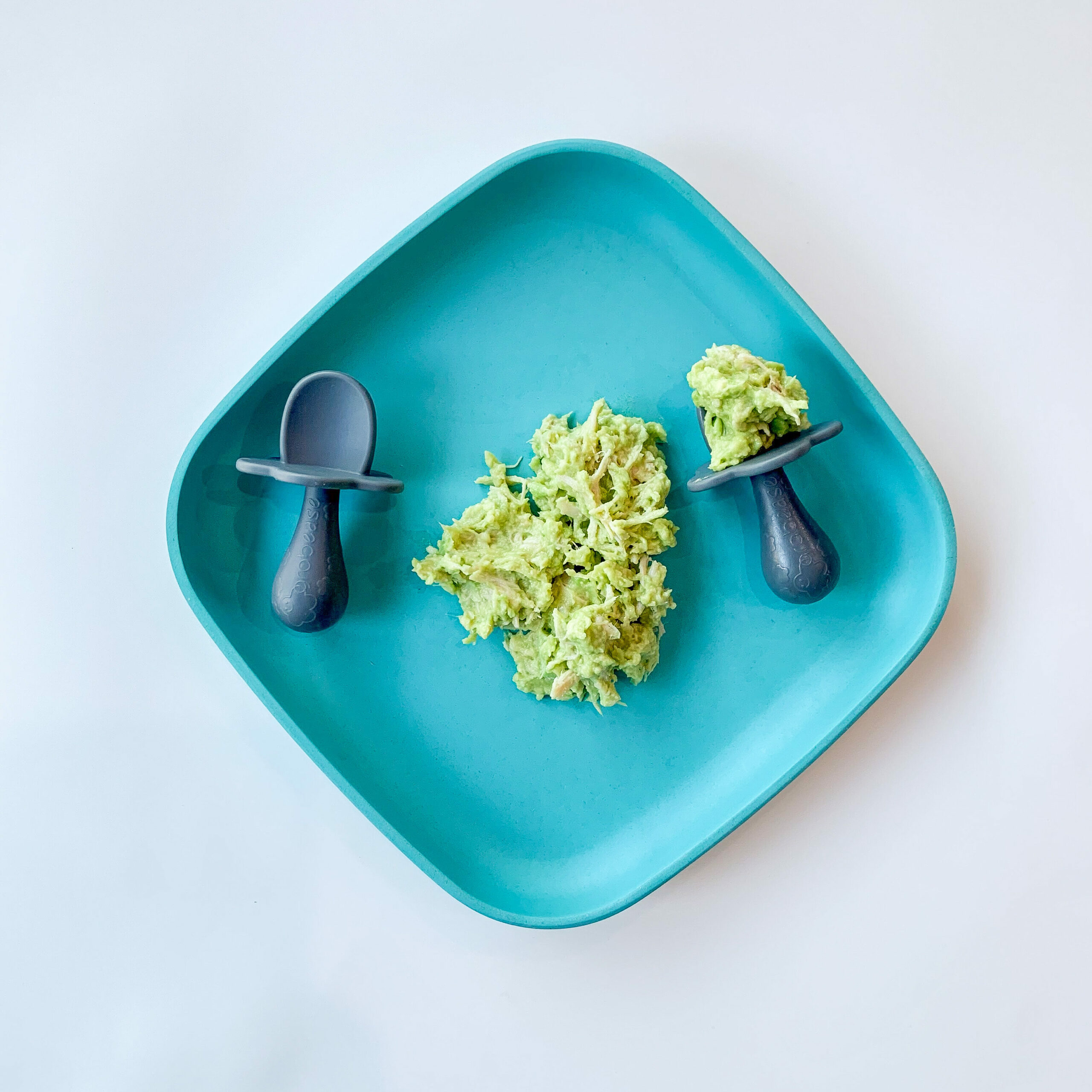
- Chicken avocado salad with quinoa: simply mix finely shredded chicken with mashed avocado. Spread mixture on toast or mix with cooked quinoa or rice for a satisfying lunch option.
- Simple Chicken Noodle soup: Finely chop vegetables (carrots, onion, celery) and sauté in a pot until soft. Add in a minced clove of garlic, dried herbs and a bay leaf (optional) to add more flavor. Pour no salt added chicken broth over the vegetables and bring to a boil. Add in noodles and continue to simmer until noodles are almost cooked fully. Take off the heat and let your soup cool. The noodles will be fully cooked once the soup has cooled. Mix in pre-shredded cooked chicken to your soup. My kids love the small star shaped pastina noodles in chicken noodle soup! For new eaters try straining most of the broth from the soup contents before serving. This will make it easier for them to manage the soft soup contents in their mouth!
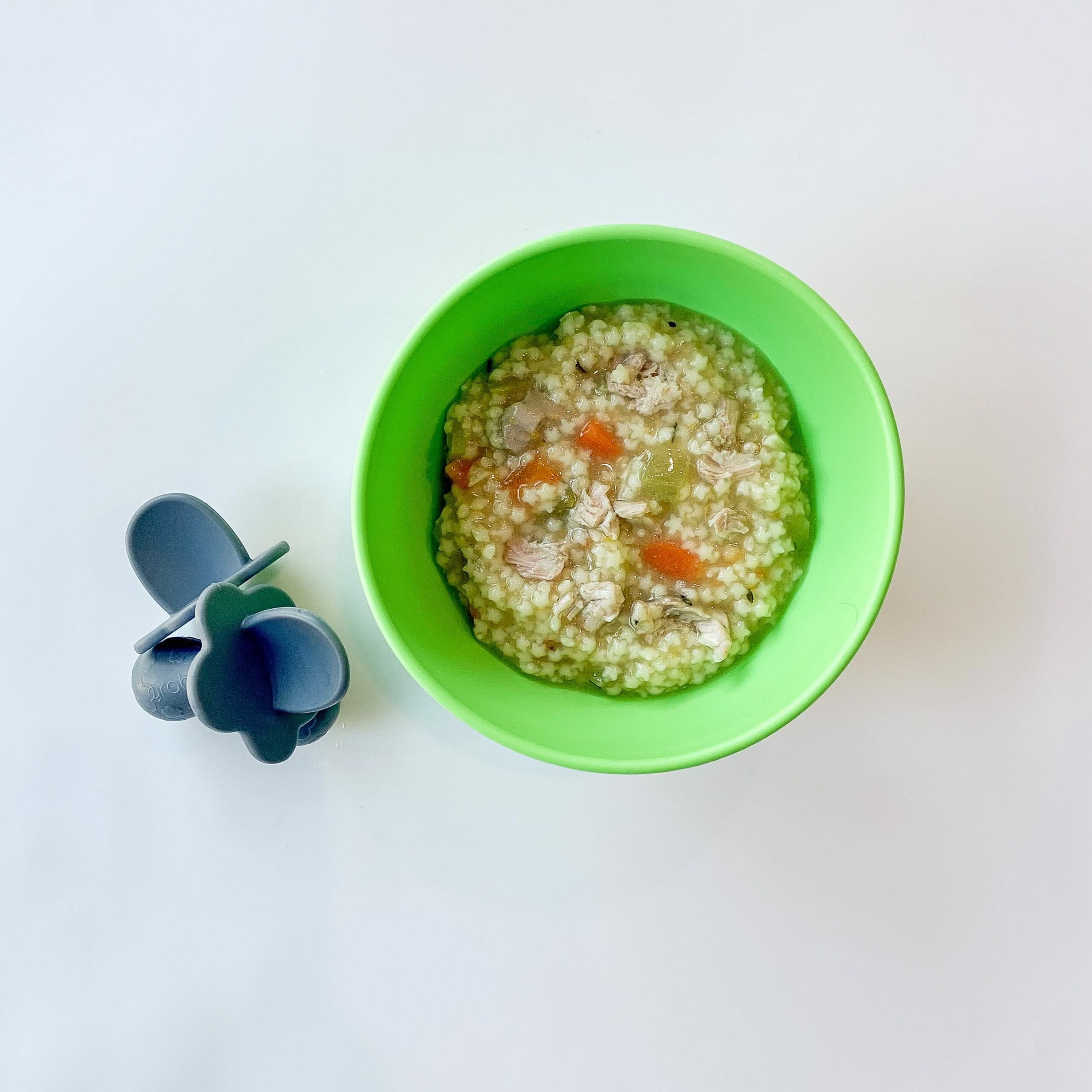
Dinner ideas:
- Chicken meat sauce and pasta: Cook ground chicken in a pan with vegetable oil, breaking it apart into small pieces. I like to add finely shredded carrot and zucchini into the meat to add flavor, texture, fibre and nutrients! Once the meat and veggies are fully cooked, add in homemade or store-bought low sodium tomato sauce. Serve over soft-cooked pasta for a balanced supper option!
- Chicken sweet potato meatballs: try out this 4-ingredient recipe, but instead of turkey use ground chicken! I would recommend shaping the meat balls into fingerlike shapes instead of balls to make it easier for your little one to pick up.
FAQ about baby-led weaning with chicken
If chicken is not properly prepared and served in a safe texture to baby, it can pose as a choking risk. In particular, chunks of firm chicken can be difficult for baby to chew and break down, increasing the risk of it becoming lodged in their throat. To safely prepare chicken, ensure that the meat is moist, and in small enough pieces for baby to safely manage and swallow. For example, firm cubes of cooked chicken can be chopped down into smaller pieces and mixed with a sauce or mash (like mashed avocado) so that it can be safely chewed and swallowed by your little one. Read this post for information on common choking hazards.
Chicken does not make it onto the common food allergen list, so you do no have to worry that your little one will have a allergic reaction to chicken. However, it is not impossible to be allergic to chicken. If your baby has any family history of a chicken allergy, and you are concerned, do not hesitate to reach out to your pediatrician.
Yes! In fact, darker cuts of chicken like chicken thighs, or drumsticks contain more iron than the white meat or chicken breast. Refer to the “benefits of chicken” section above for more nutrition facts about chicken!
Free-range chickens are required to have access to the outdoors, however there is no legal definition for this in Canada so the amount of time, and how much outdoor space they have access to varies from farm to farm. Free-run chickens are raised differently in that they do not need to have access to the outside, but are able to run around freely in-doors. All chickens raised for meat in Canada are considered free-run (5). There is no evidence to support health benefits from consuming free-range chicken over free-run chicken. In fact, in Canada, all chicken (and other meat) come from farms with high standards of quality and animal care. Learn about how chickens can be raised in Canada.
Delicious baby-led weaning chicken recipes:
- Chicken Squash Cauliflower Baby Food
- Slow Cooker Chicken Curry – how to make it baby friendly!
- Classic Chicken Soup
- Simple Chicken Drumsticks
- Chicken Veggie Baked Nuggets
References:
- Meat consumption per capita Canada 2021 | Statista
- Nutrient profile (canada.ca)
- Chicken and Food Safety | Chicken.ca
- Infant Nutrition – Complementary Feeding Summary of Recommendations and Evidence (pennutrition.com)
- The Wheel of Chicken – Understanding Your Choices | Chicken Farmers of Canada
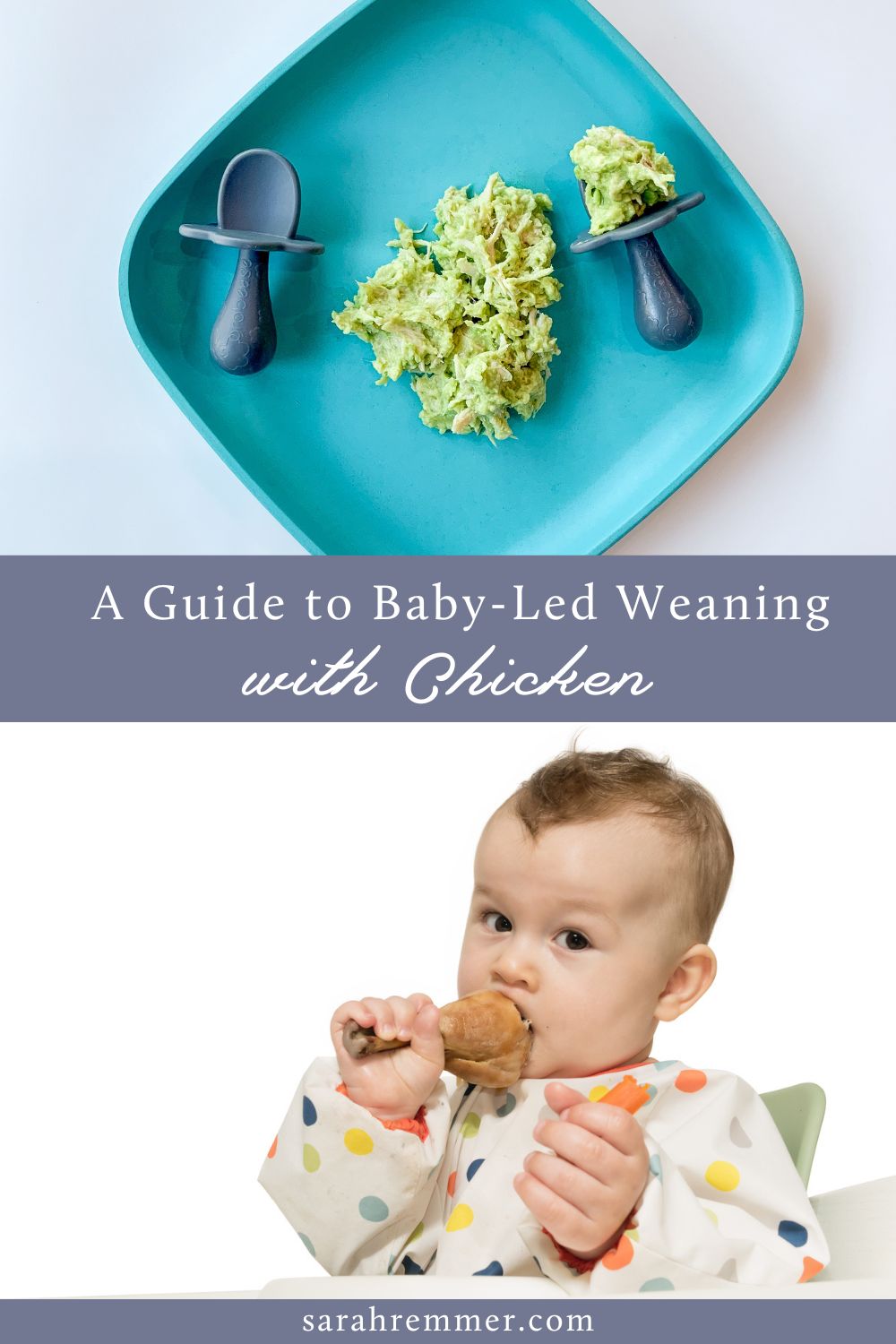
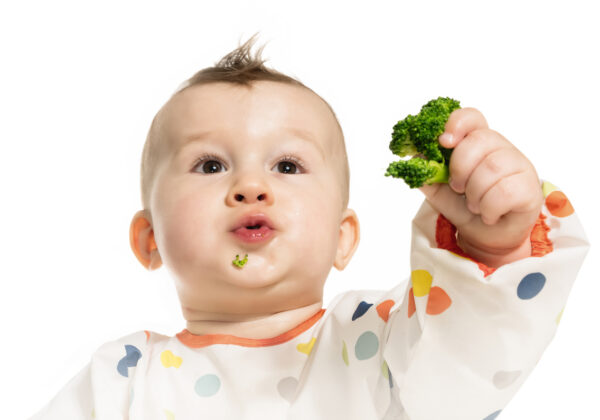
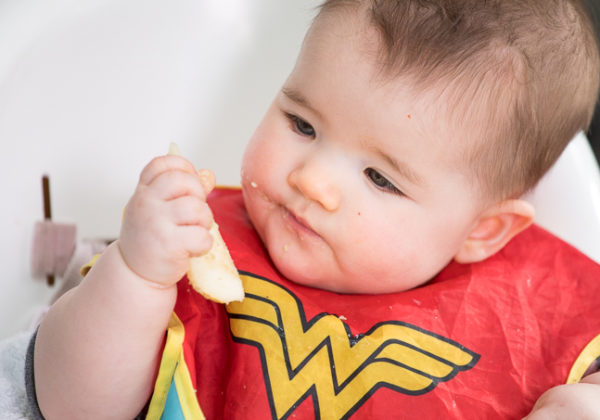
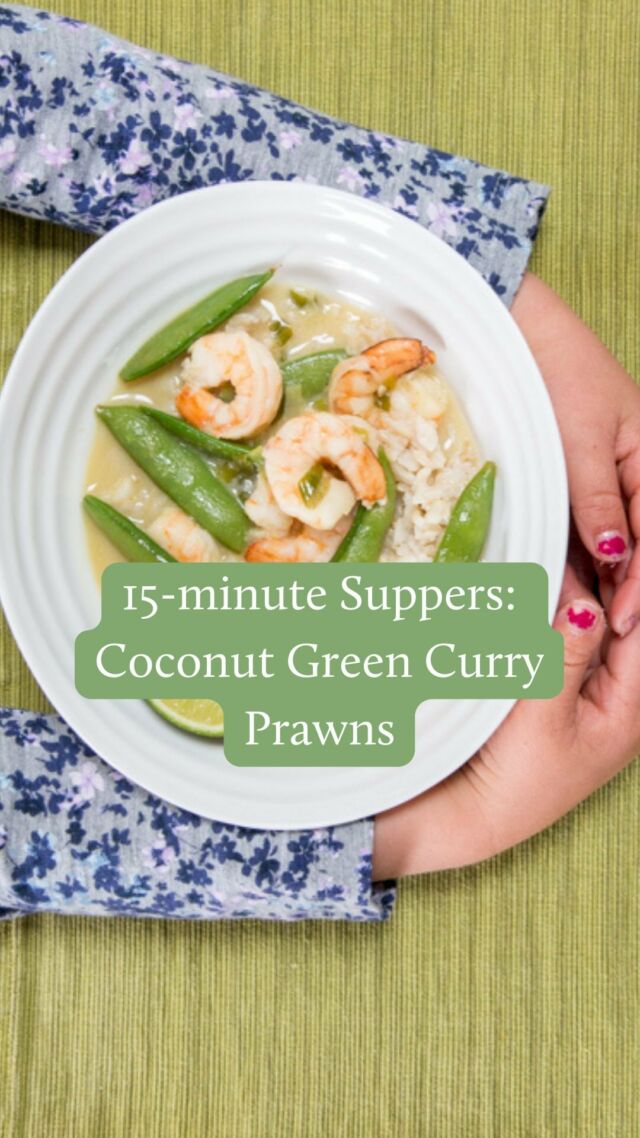

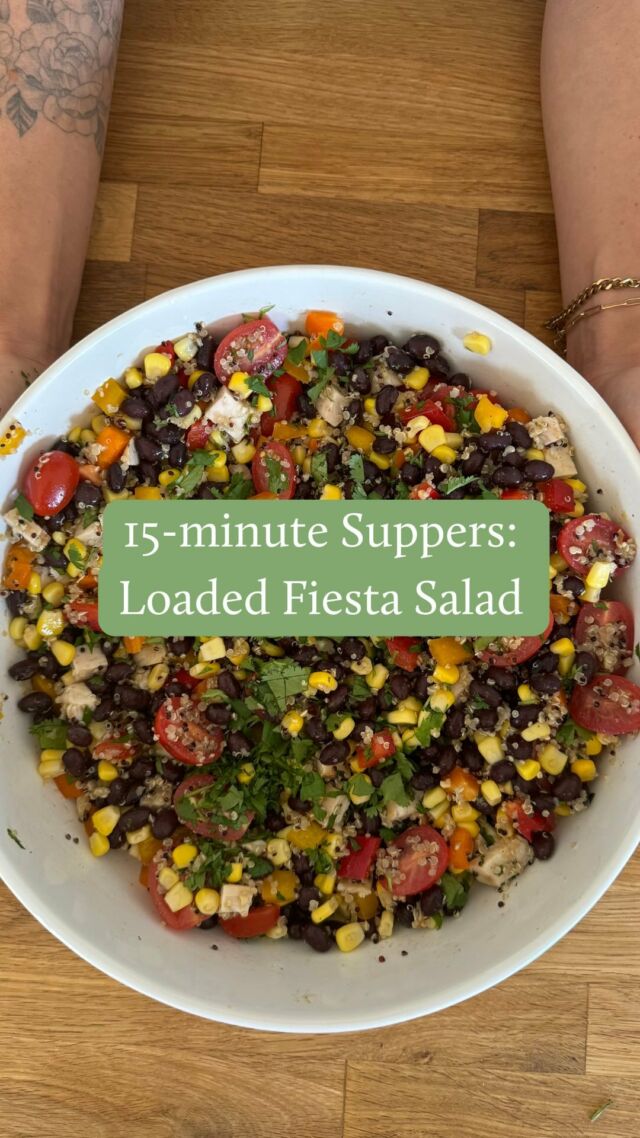



Leave a Comment